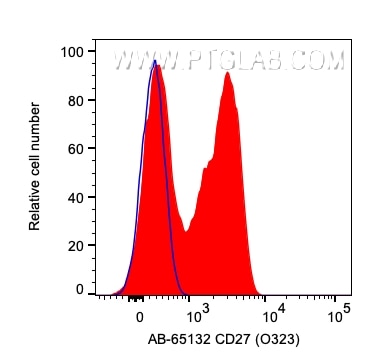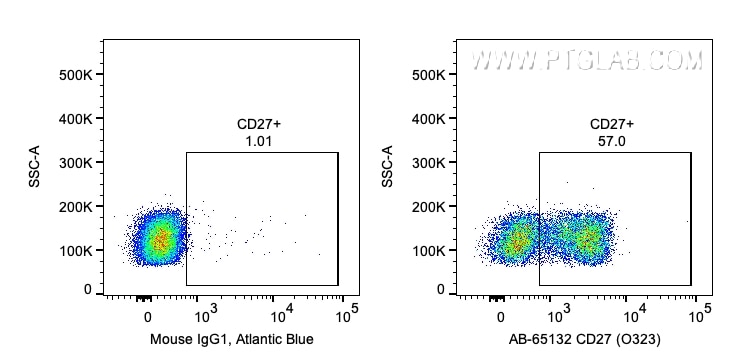Atlantic Blue™ Anti-Human CD27 (O323)
CD27 Monoclonal Antibody for FC
Host / Isotype
Mouse / IgG1, kappa
Reactivity
Human
Applications
FC
Conjugate
Atlantic Blue™ Fluorescent Dye
CloneNo.
O323
Cat no : AB-65132
Synonyms
Validation Data Gallery
Tested Applications
| Positive FC detected in | human PBMCs |
Recommended dilution
| Application | Dilution |
|---|---|
| This reagent has been pre-titrated and tested for flow cytometric analysis. The suggested use of this reagent is 5 μl per 10^6 cells in a 100 µl suspension or 5 μl per 100 µl of whole blood. | |
| Sample-dependent, Check data in validation data gallery. | |
Product Information
AB-65132 targets CD27 in FC applications and shows reactivity with Human samples.
| Tested Reactivity | Human |
| Host / Isotype | Mouse / IgG1, kappa |
| Class | Monoclonal |
| Type | Antibody |
| Immunogen | N/A 相同性解析による交差性が予測される生物種 |
| Full Name | CD27 molecule |
| Calculated molecular weight | 29 kDa |
| GenBank accession number | BC012160 |
| Gene symbol | CD27 |
| Gene ID (NCBI) | 939 |
| Conjugate | Atlantic Blue™ Fluorescent Dye |
| Excitation/Emission maxima wavelengths | 404 nm / 458 nm |
| Form | Liquid |
| Purification Method | Affinity purification |
| Storage Buffer | PBS with 0.09% sodium azide and 0.5% BSA. |
| Storage Conditions | Store at 2-8°C. Avoid exposure to light. Stable for one year after shipment. |
Background Information
CD27 (also known as TNFRSF7) is a type I glycoprotein expressed on some B cells and the majority of T cells, and is a member of the tumor necrosis factor (TNF) receptor family. CD27 is required for generation and long-term maintenance of T cell immunity (PMID: 11062504). It is a receptor for CD70 (CD27L). Ligation of CD27 by CD70 induces strong ubiquitination of TRAF and the activation of both canonical and non-canonical NF-kappaB pathways, as well as the JNK pathway (PMID: 19426224). CD27 may also play a role in apoptosis through association with SIVA1.
Protocols
| Product Specific Protocols | |
|---|---|
| FC protocol for Atlantic Blue™ CD27 antibody AB-65132 | Download protocol |
| Standard Protocols | |
|---|---|
| Click here to view our Standard Protocols |



